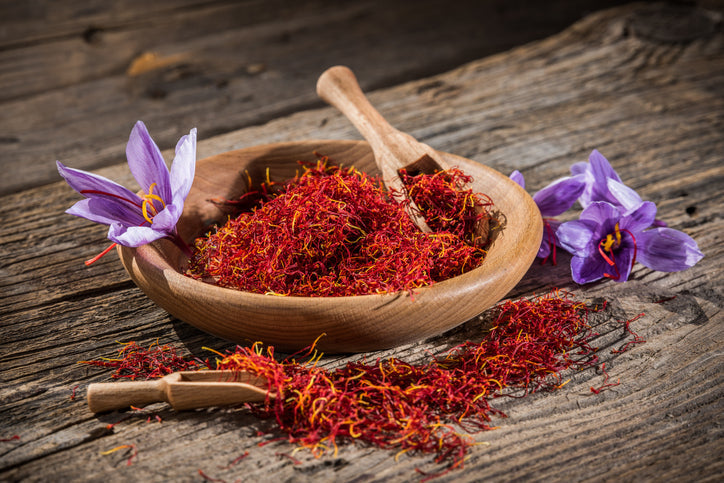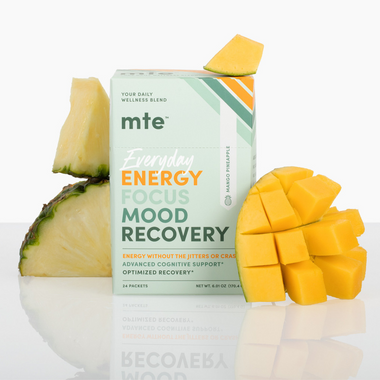
Saffron: Origins, History & Health Benefits
In some form or another, saffron has been interwoven with humans for at least 6000 years. Its scientific name is Crocus sativus, but the name “saffron” is most likely derived from the ancient Persian word “zarparan,” meaning “to have golden stigmas,” or the ancient Arabic word “za-feran,” meaning “yellowish.”
Saffron is one of the most expensive herbs in the world because it’s hard to grow and harvest.
The species of saffron traded today are not found in the wild and cannot reproduce without human intervention. On top of that, you need to grow a tonne of saffron plants just to harvest the stigmas – those little red fibers you add to curries and paella to give it that yellow color and savory, aromatic flavor. Hence the high-demand, low-supply, way-too-expensive vibe.
There is ample evidence saffron drinks have been used medicinally for several millennia. This plant shows up on frescoes, in medical texts, and in poetry all over the world. At some points in history, it was more valuable than gold, which is why it’s sometimes referred to as red gold.
The Ancient History of “Red Gold”
The saffron we know and love is thought to originate from what are today Western Afghanistan and Eastern Iran. But it might also be from Greece. Or Mesopotamia. Oh, and there’s a wild, very-close cousin that grows in Central Asia.
Because of its extensive history in culinary and medicinal use, saffron is now also grown in North America, South America, and Africa. Per usual, Australia is left out, playing by itself on the other side of the Wallace Line.
Let’s look at some highlights of documented evidence of saffron use in different ancient cultures:
- Iraq, 30-50,000 BP: Saffron-based pigments are used to depict animals in cave paintings.
- Akkadia, 4300 BP: Emperor Sargon of Akkad is said to have originally been from Azupiranu, which is often referred to in ancient texts as “Saffron City.”
- Crete, 3600 BP: Minoan frescoes depict the annual saffron harvest and offering to the gods.
- Egypt, 3200 BP: Physicians use saffron in immune tonics and royal perfumes. Saffron powder is mixed with water and used as eye drops to prevent cataracts.
- Persia, 3000 BP: Saffron threads are woven into royal textiles like rugs and tapestries. Saffron drinks are used as a way to boost low mood and melancholy.
- Greece, 2000 BP: The physician Dioscorides documents the usefulness of saffron teas in treating shingles.
- Rome, 2000 BP: Medical writer Aulus Cornelius Celsus documents saffron as a treatment for colic, cough, scabies, and open wounds.
Other ancient and historic instances of saffron in medicine include:
- Gilgamesh’s perfumer is said to have used saffron salves to treat the emperor’s painful legs.
- Alexander the Great was said to use almost a cup of saffron a day in drinks, baths, and other concoctions. He is also credited with the Eastern spread of saffron into India and East Asia following his conquests.
- Saffron is used in Indian Ayurvedic medicine, likely beginning after Alexander the Great.
- Cleopatra is said to have taken saffron-laced baths as an aphrodisiac.
- In Medieval England, saffron teas were used against the Black Death.
- In Nuremberg, there was a law in the Middle Ages that set fines, imprisonment, and even execution for stealing saffron.
- In 14th-century Austria, there was an actual dispute about the saffron trade so violent it became known as the Saffron War.
The list is endless, really. Suffice to say, saffron has been here a long time, and it certainly isn’t going anywhere. And like all adaptogens, nootropics, and superfoods in MTE, this ancient nootropic has some science behind its medicinal magick.
Modern Research on Saffron’s Health-Supporting Abilities
Since saffron’s relationship with humans is eons-long, modern medical research has a great foundation to start with when asking how to uncover and prove saffron’s medicinal abilities.
Saffron may be a nootropic, but it’s also a superfood. Its nutritional profile includes vitamins, minerals, antioxidants, and carotenoids, including four of the most powerful antioxidants we know of: safranal, pricocrococin, crocin, and crocetin.
The vital compounds that make saffron so super are highly bioavailable, which means your body can make use of most of what’s ingested. This is what gives saffron its health-boosting abilities.
The powerful antioxidants in saffron support against oxidative stress, which contributes to over 100 physical, mental, and neurological conditions.
Notably, the carotenoids are such that the body doesn’t alter them on their way to your bloodstream. As well, these carotenoids are water-soluble, which is what makes beverages an effective way to supplement with saffron.
MTE uses a premium extract of the saffron plant, Affron®, which contains these concentrated active compounds.
Numerous scientific reviews from 2008 to 2018 observed the posited bioactivity of saffron, including inhibition of tumor growth, protective effects on the hippocampus, liver, and heart, and increment ocular blood flow, particularly via its antioxidant compounds:
- Clinical research demonstrates that crocetin, a main antioxidant compound in saffron, benefits the endocrine, immune, reproductive, central nervous, cardiovascular, and gastrointestinal systems.
- A rat study suggested crocetin and crocin have neuroprotective effects on the brain.
- Pricocrococin, a main antioxidant compound in saffron, has demonstrated anti-proliferative properties on human cell cancers.
- Safranal and crocetin have both demonstrated high radical-scavenging abilities in the body.
Let’s look at some select purposes and evidence for saffron’s use in medicine over the last 3 decades of clinical research:
- 1996: A study on the cytotoxicity of saffron indicated significant cell growth inhibition in human cancer cells at specific doses.
- 2000: A study on learning and memory observed saffron supplementation reduces cognitive impairments and protects hippocampal activity, suggesting saffron as an effective ingredient in the treatment of neurodegenerative disorders.
- 2007: A study on transient cerebral ischemia demonstrated the crocin in saffron may have protective effects on oxidative stress in the brain, making it a potential preventative treatment for strokes.
- 2008: A study on the effects of saffron extracts on DNA damage saw crocin administration reduce and reverse DNA damage to the liver, kidneys, heart, lungs, and spleen.
- 2010: A randomized, placebo-controlled study suggested that saffron supplementation may reduce snacking behaviors by increasing satiety, meaning it may be a useful tool in a weight loss plan.
- 2013: A meta-analysis of clinical trials showed that, across the board, saffron supplementation significantly reduced the severity of chronic low mood compared to placebo controls.
- 2013: A study on age-related free-radical damage and oxidative stress on the liver suggested safranal has the potential to suppress age-related liver damage.
- 2017: A meta-analysis of the studies on cognitive decline and saffron supplementation shows that medical research supports the claims of saffron’s ability to protect brain cells, improve memory and cognition, inhibit the proliferation of harmful proteins, and scavenge free radicals, reducing oxidative damage.
While this list isn’t necessarily endless, it’s still extensive and certainly intriguing. A search through current research reveals that the scientific community isn’t really disputing the usefulness of saffron but rather exploring the mechanisms, potential applications, dosages, and efficacy of saffron as a treatment for various ailments.
How to Prepare Saffron Water?
Lately, drinking saffron water has become a popular trend for its potential health benefits. Fans of this golden spice sip it to support mood, digestion, immunity, and even skin health.
If you’re curious about trying it, here’s how to prepare saffron water for the best effects:
- Use high-quality saffron threads to ensure maximum potency. Look for vibrant red strands with minimal yellow to ensure purity.
- Use 4–5 threads for one glass of water. This is enough to extract the beneficial compounds without overpowering the flavor.
- Place the threads in a glass of warm water (not boiling because hot water can destroy saffron’s delicate compounds).
- Let it steep for at least 15–20 minutes. For an extra boost, you can let it steep overnight in the refrigerator.
- If you prefer a slightly sweet or tangy taste, add a teaspoon of honey or a splash of lemon juice.
- Drink it first thing in the morning on an empty stomach for optimal absorption, or enjoy it mid-afternoon as a calming, revitalizing pick-me-up.
While saffron water is a great way to experience the benefits of this ancient spice, there’s an even simpler option. MTE includes Affron, a premium, standardized saffron extract that delivers these same potent compounds.
With MTE, you get the benefits of saffron alongside adaptogens, nootropics, and superfoods –all in a convenient, ready-to-mix wellness energy drink alternative. It’s an easy way to support your health without the extra preparation.
Affron®: A Standardized Saffron Extract with Potent Abilities
As we mentioned before, MTE uses Affron in place of saffron in our health-and-energy-boosting green powder. Affron is a premium, standardized extract of saffron comprised of its two most powerful carotenoids, safranal and crocin.
Affron focuses on a few of saffron’s specific abilities, namely, mood and brain health support. In clinical settings, Affron supplements have demonstrated anti-depressant, anti-anxiety and anti-anhedonic abilities.
There is also data to support Affron as a nootropic for recovery.
Interested in learning more about how a daily saffron drink supplement that contains adatogens, nootropics, and superfoods can support your quality of life? We’re talking way more than just a natural energy drink.
MTE is a daily wellness drink full of feel-good ingredients that promote a tranquil mood, steady energy, peak performance, and clear cognition.
Try MTE and feel the difference – steady energy, sharper focus, better mood, restful sleep, and more.






